#Megalops atlanticus
Text
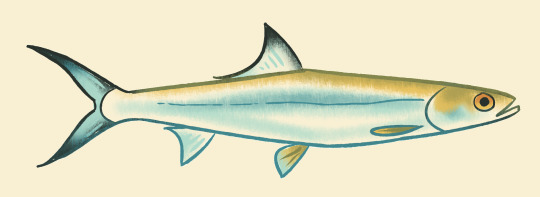
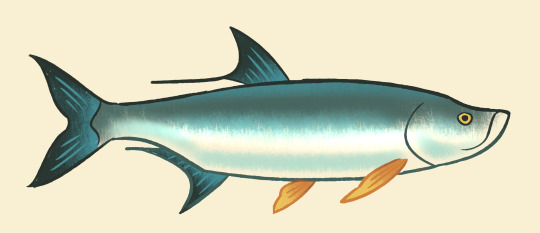
54 common fish of texas, part 12: ladyfish (Elops saurus), tarpon (Megalops atlanticus)
83 notes
·
View notes
Text

Tarpon, Megalops atlanticus
946 notes
·
View notes
Photo

Tarpones en San Crisanto 🐟 Megalops atlanticus #fishlovers #sancrisanto #yucatan #yucatancoast #fish #fisk #sea #cenote #dzonot #pez #peces #ictiology #ictiologia #mar #mexico #tarpon #megalops #atlanticus #caribbean #gulfofmexico
#pez#megalops#gulfofmexico#yucatancoast#fisk#yucatan#dzonot#tarpon#fishlovers#atlanticus#peces#mar#sancrisanto#sea#fish#ictiology#ictiologia#caribbean#cenote#mexico
10 notes
·
View notes
Text
The Bounty of Charlotte Harbor
The Bounty of Charlotte Harbor
Article by Scott Davis, Photos by Dale Sanders
Have you ever fantasized about having the opportunity to play an early morning round of golf on a five star golf course, completing an inshore fishing grand slam of snook, redfish and tarpon in the afternoon, then finishing the day at an award winning restaurant? Or, maybe a sunset stroll on an unspoiled beach? You’re in luck, visitors can find all…
View On WordPress
#Big Boca Ale#Charlotte Harbor#Chef Jeanie Roland#Dale Sanders#Englewood Beach#Fat Point#Leroy’s Southern Kitchen & Bar#Megalops Atlanticus#Punta Gorda#Pure Florida#The Blue Turtle#The Wyvern Hotel#Wyvern Hotel
0 notes
Text
All about Tarpon
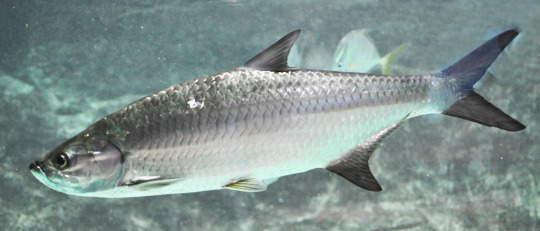
The Tarpon, Megalops atlanticus
Green or steel blue above, silver on sides and paunch. Profound, thick body; forked tail. Long trailer at end of dorsal balance.
Different NAMES: Silver King, Sabalo
Depiction: Green or steel blue above, silver on sides and tummy. Profound, thick body; forked tail. Long trailer at end of dorsal balance.
By and large, albeit enormous fish of 100 to 150 pounds are various in numerous zones. World record 286 pounds, 9 ounces; Florida record 243 pounds.
FOOD VALUE: None.
GAME QUALITIES: Famous for the display and recurrence of its hops. Goliath Tarpon don't exactly coordinate the tumbling of the littler ones, yet they jump as often as possible enough in shallow water, and with significantly more wrath.
TACKLE AND BAITS: Anglers looking for enormous fish in passes, channels, profound coves and surf zones like bold tackle with lines testing in any event 30 pounds. All sizes of turning, baitcasting and fly tackle get loads of play for littler fish. Similar sorts of rigging, in spite of the fact that of heavier extents, are likewise utilized for huge fish on shallow pads. Use at any rate 15-pound line on turning and throwing gear, and in any event a 10-weight fly outfit with least 16-pound scarf. Overwhelming monofilament pioneers or scarfs are required in view of the Tarpon's harsh mouth. Float anglers in the passes and deltas lean toward live snares—fundamentally little crabs and little fish.
Read the full article
0 notes
Photo

Atlantic Tarpon (Megalops atlanticus) by krismikael A group of tarpons accompanied us during our night dives on Bonaire. These nocturnal hunters exploited the light from our torches to find prey.
15 notes
·
View notes
Photo
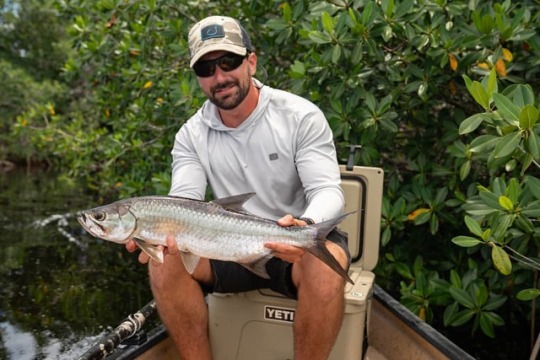
Megalops Atlanticus minius or whatever the small ones are called 🤷♂️ (at Everglades National Park) https://www.instagram.com/p/B1V9wGnDLQz/?igshid=15eq7ve2y52xn
0 notes
Text
Manila Ocean Park
Freshwater Organisms
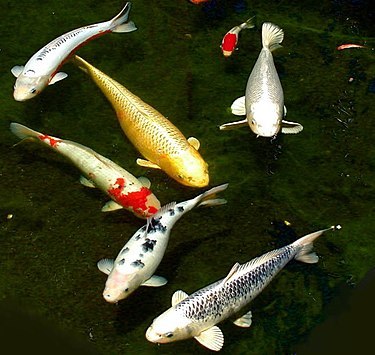
Koi
Colored varieties of Amur carp (Cyprinus rubrofuscus) that are kept for decorative purposes in outdoor koi ponds or water gardens.
Koi is an informal group of the colored variants of C. carpio. Several varieties are recognized by the Japanese. Koi varieties are distinguished by coloration, patterning, and scalation. Some of the major colors are white, black, red, orange, yellow, blue, and cream. The most popular category of koi is the Gosanke, which is made up of the Kohaku, Taisho Sanshoku, and Showa Sanshoku varieties.
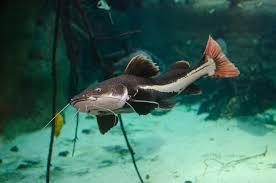
Catfish
A diverse group of ray-finned fish. Named for their prominent barbels, which resemble a cat's whiskers, catfish range in size and behavior from the three largest species alive, the Mekong giant catfish from Southeast Asia, the wels catfish of Eurasia and the piraíba of South America, to detritivores(species that eat dead material on the bottom), and even to a tiny parasitic species commonly called the candiru, Vandellia cirrhosa. There are armour-plated types and there are also naked types, neither having scales.

Danio rerio
A freshwater fish belonging to the minnow family (Cyprinidae) of the order Cypriniformes.Native to the Himalayan region, it is a popular aquarium fish, frequently sold under the trade name zebra danio (and thus often called a "tropical fish" although not native to the tropics). The zebrafish is also an important and widely used vertebratemodel organism in scientific research, for example in drug development, in particular pre-clinical development. It is also notable for its regenerative abilities, and has been modified by researchers to produce many transgenic strains.

Freshwater Angelfish
A small genus of freshwater fish from the family Cichlidae known to most aquarists as angelfish. All Pterophyllum species originate from the Amazon Basin, Orinoco Basin and various rivers in the Guiana Shield in tropical South America. The three species of Pterophyllum are unusually shaped for cichlids being greatly laterally compressed, with round bodies and elongated triangular dorsal and anal fins. This body shape allows them to hide among roots and plants, often on a vertical surface. Naturally occurring angelfish are frequently striped longitudinally, colouration which provides additional camouflage. Angelfish are ambush predators and prey on small fish and macroinvertebrates. All Pterophyllum species form monogamous pairs. Eggs are generally laid on a submerged log or a flattened leaf. As is the case for other cichlids, brood care is highly developed.

Red-Tailed Tinfoil Barb
The tinfoil barb (Barbonymus schwanenfeldii) is a tropical Southeast Asian freshwater fish of the family Cyprinidae. It is distinguishable from other species of the genus in having a red dorsal fin with a black blotch at the tip, red pectoral, pelvic and anal fins, red caudal fin with white margin and a black submarginal stripe along each lobe, and 8 scale rows between dorsal-fin origin and lateral line. Large individuals are silvery or golden yellow while alive with its dorsal fin red and caudal fin orange or blood-red. It grows up to 14 inches (35 cm) in length. Tinfoil barbs have a lifespan of 8 to 10 years.

Indo-Pacific Tarpon
In appearance, it is like the Atlantic tarpon, Megalops atlanticus: olive-green on top, and silver on the sides. The large mouth is turned upwards; the lower jaw contains an elongated, bony plate. The last ray of the dorsal fin is much longer than the others, reaching nearly to the tail. It is capable of filling its swim bladder with air and absorbing oxygen from it. Those living in fresh water tend to be smaller than the ones living in saltwater, growing just over 50 cm (20 in), while saltwater examples grow over 1 m (3.3 ft). They live upwards of 44 years and mature within two. They complete their metamorphosis from their larval stage in ten days.

Clown Knifefish
Anocturnal tropical fish with a long, knife-like body. This knifefish is native to freshwater habitats in Cambodia, Laos, Thailand and Vietnam, but it has also been introducedto regions outside its native range. It is one of world's most invasive species.
It is often seen in aquaculture and the aquarium trade where frequently confused with Chitala chitala; the latter species is very rare in the aquarium trade.Despite its popularity, the clown featherback reaches 1 m (3.3 ft) in length, outgrowing all but the largest aquaria.

Giant Gourami
A species of large gourami native to freshwater habitats in Southeast Asia, with its occurrence in other locations due to introductions. This species is commercially important as a food fish and is also farmed. It can also be found in the aquarium trade.The species has been used for weed control, also on highly invasive aquatic plants like Salvinia molesta, as the giant gourami can be a voracious herbivore.

Black and Red-Bellied Pacu
Pacu is a common name used to refer to several species of omnivorous South Americanfreshwater serrasalmid fish that are related to the piranha. Pacu and piranha do not have similar teeth, the main difference being jaw alignment; piranha have pointed, razor-sharp teeth in a pronounced underbite, whereas pacu have squarer, straighter teeth, which are uncannily similar to human teeth, and a less severe underbite, or a slight overbite. Pacu, unlike piranha, mainly feed on plant material and not flesh or scales. Additionally, the pacu can reach much larger sizes than piranha, at up to 1.08 m (3.5 ft) in total length and 40 kg (88 lb) in weight.

Alligator Gar
A ray-finned euryhaline fish related to the bowfin in the infraclass Holostei/hoʊˈlɒstiaɪ/. It is the largest species in the gar family, and among the largest freshwater fishes in North America. The fossil record traces its existence back to the Early Cretaceous over a hundred million years ago. Gars are often referred to as "primitive fishes", or "living fossils" because they have retained some morphological characteristics of their earliest ancestors, such as a spiral valve intestine which is also common to the digestive system of sharks, and the ability to breathe both air and water. Their common name was derived from their resemblance to the American alligator, particularly their broad snout and long, sharp teeth. Anecdotal evidence in several scientific reports suggest that an alligator gar can grow up to 10 ft (3.0 m) in length.
Marine Organisms

Moorish Idol
A marine fish species, the sole extant representative of the family Zanclidae in order Perciformes. A common inhabitant of tropical to subtropical reefs and lagoons, the Moorish idol is notable for its wide distribution throughout the Indo-Pacific. A number of butterflyfishes (genus Heniochus) closely resemble the Moorish idol. It is closely related to, if not a direct descendant of, the extinct Eozanclus brevirostris, from the Middle Eocene of Monte Bolca.

Blue Tang
Paracanthurus hepatus has a royal blue body, yellow tail, and black "palette" design. The lower body is yellow in the west-central Indian Ocean. It grows to 30 cm (12 in). Adults typically weigh around 600 g (21 oz) and males are generally larger than females. This fish is rather flat, like a pancake, with a circular body shape, a pointed snout-like nose, and small scales. The blue tang has nine dorsal spines, 26–28 dorsal soft rays, three anal spines, and 24–26 anal soft yellow rays.
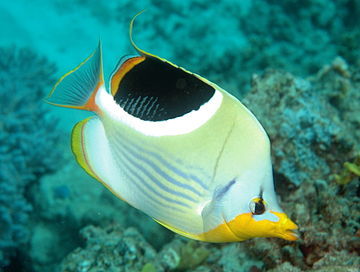
Butterfly Fish
The butterfly fish is a generally small-sized species of marine fish, found in tropical and subtropical waters, primarily around coral reefs. The butterfly fish is well known for its brightly coloured body and elaborate markings.
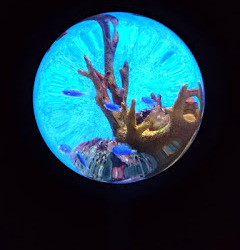
Blue Damsel Fish
Chrysiptera parasema, also known as yellowtail damselfish, yellowtail blue damsel, goldtail demoiselle, and other variations, is a popular saltwater aquarium fish from the Indo-Pacific.

Banded Humbug
Dascyllus aruanus, known commonly as the whitetail dascyllus or humbug damselfish among other vernacular names, is a species of marine fish in the family Pomacentridae. Banded humbugs are common inhabitants of shallow coral reefs.
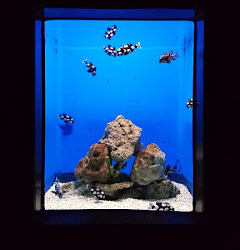
Harlequin Sweetlips
Plectorhinchus chaetodonoides, the harlequin sweetlips, is a species of grunt native to the Indian Ocean and the western Pacific Ocean. It is a denizen of coral reefs found at depths of from 1 to 30 m. It can reach 72 cm in TL. The heaviest known individual weighed 7 kg.

Manila Pufferfish
Found singly over mud, sand, seagrass beds and silty areas of sheltered estuaries, shallow lagoons, seaward reefs and estuaries. The bodies of Pufferfish are covered in a toxic mucus, if the skin or flesh is consumed it can be fatal to humans. When threatened they will puff up like a football to deter predators.
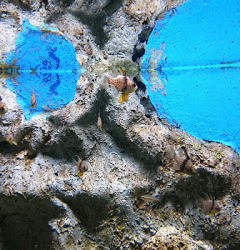
Pajama Cardinal Fish
The pajama cardinalfish, spotted cardinalfish, coral cardinalfish, or polkadot cardinalfish is a species of fish belonging to the family Apogonidae. It is a popular aquarium fish. The Pajama Cardinalfish is a rainbow of playful colors. It has a greenish-yellow face, bright orange eyes, and a silver-based body.

Clown Fish
Clownfish or anemonefish are fishes from the subfamily Amphiprioninae in the family Pomacentridae. Thirty species are recognized: one in the genus Premnas, while the remaining are in the genus Amphiprion. In the wild, they all form symbiotic mutualisms with sea anemones.
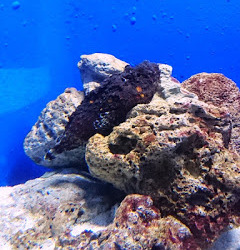
Venomous Stonefish
Synanceia is a genus of fish of the family Synanceiidae, the stonefishes, whose members are dangerously venomous and even fatal to humans. It is one of the most venomous fish known. They are found in the coastal regions of the Indo-Pacific.
0 notes
Text
The Best Time for Recreational Anglers to Catch Tarpons
According to majority of professional tarpon fishing guides the Megalops Atlanticus or Tarpon is considered as one of the most famous game fish in the Florida Keys. The reason behind this is that you will find tarpons in the keys throughout the year. From all over the globe, you will see many recreational anglers sitting around the bridges in the Florida keys searching for tarpons with live baits and artificial fishing lures.
In the Florida Keys, you will be able to catch tarpons all around the rear. Therefore it is really hard to say which particular ‘season’ is best for catching tarpons. That is why the good time to catch them can generally last longer than according to the calculations of most fishermen and keys tarpon fishing guides. There are times that more likely to be favorable in order to spot and target the tarpon, whereas, during the winter season, it can be a little challenging to spot any tarpon. This is due to the fact that tarpon doesn’t like cold weather, which is why there are fewer chances that they show up.
I prefer February to start my hunt for tarpons because some years are much better than others. Still, I don’t recommend others to come specifically in this month because the possibilities of cold fronts still remain to be pretty high, which is not suitable for tarpon. Nevertheless, if the conditions are suitable, like the warm temperature of the water, then there are chances to see some fish around.
However, there will be nothing wrong to say that April, May, and June are considered to be the best months to catch tarpon in the Florida Keys. This is the most favorable time when you will notice tarpons moving in the direction of the ocean. These months are said to be the prime months for the migration of tarpons.
I also like to fish around in the month of July, the late days of June also works fine for that matter. You will see that during this time of the year, the recreational anglers and guides will be present near the shores of the Florida Keys as there are fish in the ocean around this time as well. You can hook them more easily due to the reduced pressure, however landing them is a different story.
If you want to catch baby tarpons, then you can consider the summer and the fall season. You can find them in the oceans due to the fact that the cold fronts start in the late of October and November, and during this time, the water temperature goes down to 60 degrees. I also find that the Everglades back country near Flamingo is filled with the baby Tarpons, and can tell you that there are many experienced Tarpon anglers that actually prefer Fly Fishing Flamingo for the baby Tarps.
The answer to the question, which is the best time to catch tarpons, remains unanswered because you can catch them all through the months, but it is hard to find them.
Therefore to be precise and to sum up, I would say that if I have to recommend any particular months, then I will say that from the beginning of late days of January and February, you can find tarpons in the Florida Keys all through April, May, June, and July. If you have any questions about catching Tarpon or would like to book a Key Tarpon Charter, click here and I will be happy to respond.
from Everglades Angling https://evergladesangling.net/blog/the-best-time-for-recreational-anglers-to-catch-tarpons/
0 notes
Text
see shoals sea schools
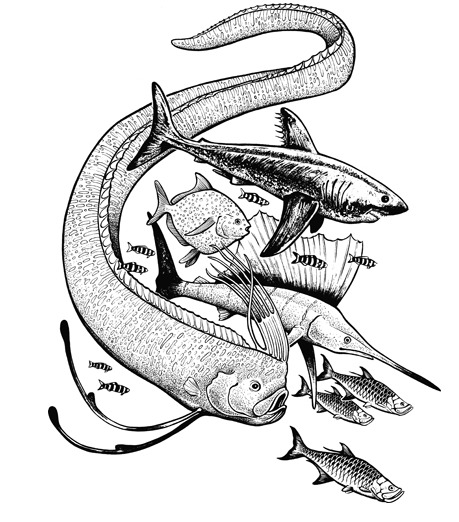
illustration by @helenscales in Eye of the Shoal : Salmon Shark Lamna ditropis; Pilotfish Naucrates ductor; Opah Lampris guttatus; Atlantic Sailfish Istiophorus albicans; Giant Oarfish Regalecus glesne; Atlantic Tarpon Megalops atlanticus
Reading the book reminded me how much I loved the strangeness of life in the sea.
Scales did field research in Palau to understand spawning behavior of Humphead Wrasse. She describes being “carefully and thoughtfully watched” by the giant male humphead. As much as I talk truthfully about being terrified of the ocean, it’s also incredible to look under the waves and encounter the aquatic other, in their territory. A shoal of manini or mamo. A solo coronet fish.
Scales begins Eye of the Shoal in the library, looking at centuries-old books about fish identification.
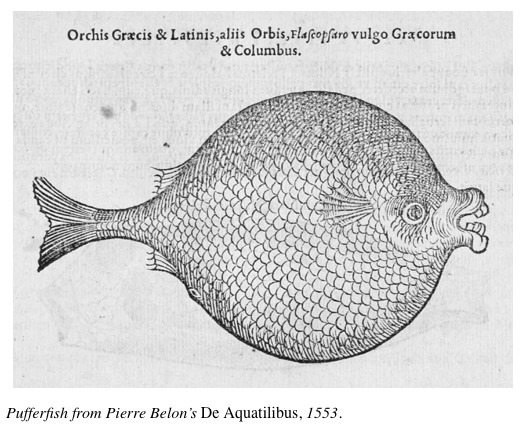
0 notes
Text
Dictionary (pt.cccliii)
Words taken from The Soul of an Octopus: A Surprising Exploration Into the Wonder of Consciousness by Sy Montgomery:
Valsalva manoeuvre (n.) ❤
a manoeuvre performed by moderately forceful attempted exhalation against a closed airway, usually done by closing one’s mouth, pinching one’s nose shut while pressing out as if blowing up a balloon.
Frenzel manoeuvre (n.)
a manoeuvre developed in 1938 that was originally taught to dive bomber pilots during World War II. The manoeuvre is used to equalize pressure in the middle ear.
vertigo (n.)
a condition with a sensation of whirling and a tendency to lose balance; dizziness, giddiness.
tarpon (n.)
a large silvery fish, Megalops atlanticus, common in the tropical Atlantic.
decompression sickness (n.)
a disorder in which nitrogen dissolved in the blood and tissues by high pressure forms bubbles as pressure decreases. Symptoms can include fatigue and pain in muscles and joints.
vasopressin (n.)
a pituitary hormone acting to reduce diuresis and increase blood pressure.
deliquesce (v.)
become liquid, melt.
statocyst (n.)
a small organ of balance and orientation in some aquatic invertebrates, consisting of a sensory vesicle or cell containing statoliths.
tyrosinase (n.)
a copper-containing enzyme present in plant and animal tissues that catalyzes the production of melanin and other pigments from tyrosine by oxidation, as in the blackening of a peeled or sliced potato exposed to air.
contrail (n.)
a visible stream of water droplets or ice crystals occurring in the engine exhaust of an aircraft, rocket, etc.
0 notes
Photo

“Megalops Atlanticus” -- Rhiannon Grey
0 notes
Text
Do Tarpon Fishing Key West
The Atlantic tarpon (Megalops atlanticus) can be found in coastal waters, estuaries, lagoons and rivers. Tarpon fishing is very popular with people in Florida and at other places also. Tarpon fish is considered to be among the most sought after sports fish so opt for Tarpon Fishing Key West. It will be an adventurous fun-filled experience to you and your pals. Tarpon fishes are quite heavy and big fishes, which can grow up to about 4–8 ft long and weigh 60–280 lbs.
You should choose opting for tarpon fishing from April-June, as tarpon can best be caught in its peak season. The peak season for tarpon fishing tends to run between April and June. This is so because tarpon migration patterns bring a huge number of them through the waters of Key West during this season time. They surely get hungry from traveling. Tarpon fishes are real game ones because they are known to prowl and jump like crazy.
Tarpon Fishing Key West this is why is so exciting and adventurous as the people trying to control it will tough fight from it, which adds on to the fun even more. If you too are interested then opt for it.
0 notes
Photo
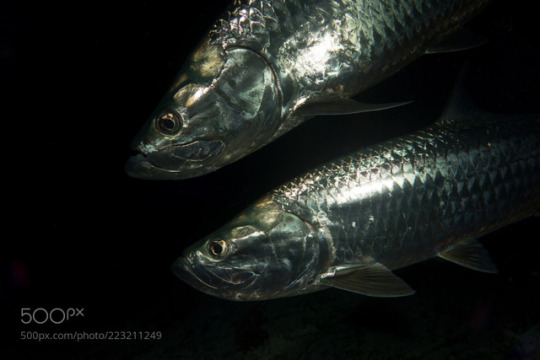
Atlantic Tarpon (Megalops atlanticus) by krismikael
0 notes
Text
Atlantic Tarpon
Megalops atlanticus
Megalops translates into great appearance, while atlanticus means coming from the Atlantic Ocean.
Family: Megalopidae (Tarpons)
Fun Fact: “The swim bladder, attached to the esophagus, can be filled directly with air and permits the fish to live in oxygen-poor waters.” (FishBase)
They are one of Alabama’s state fish.
Habitat: They are endemic to the ocean, brackish waters, and coastal areas of the Atlantic Ocean (Canada south towards Brazil, Portugal south towards Angola).
Ecosystem Role: They help control populations of smaller fish (like sardines, anchovies, and cichlids), and crustaceans.
Conservation Status: Vulnerable
2 notes
·
View notes
